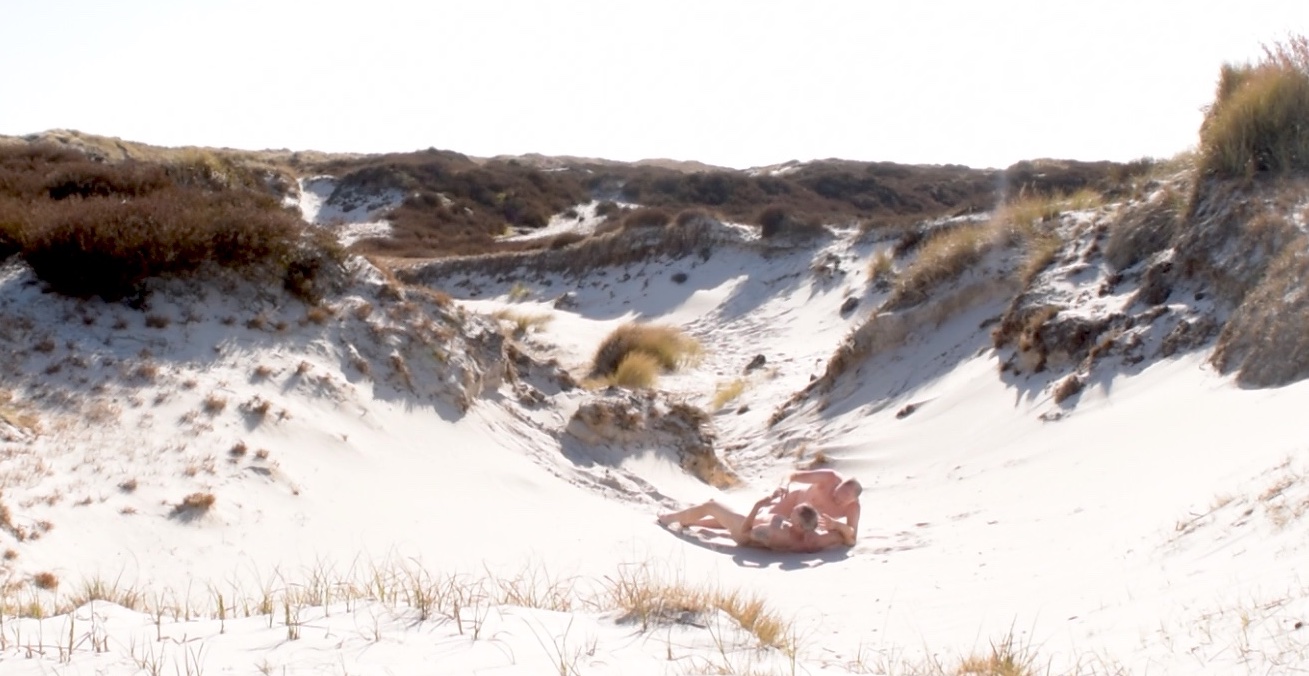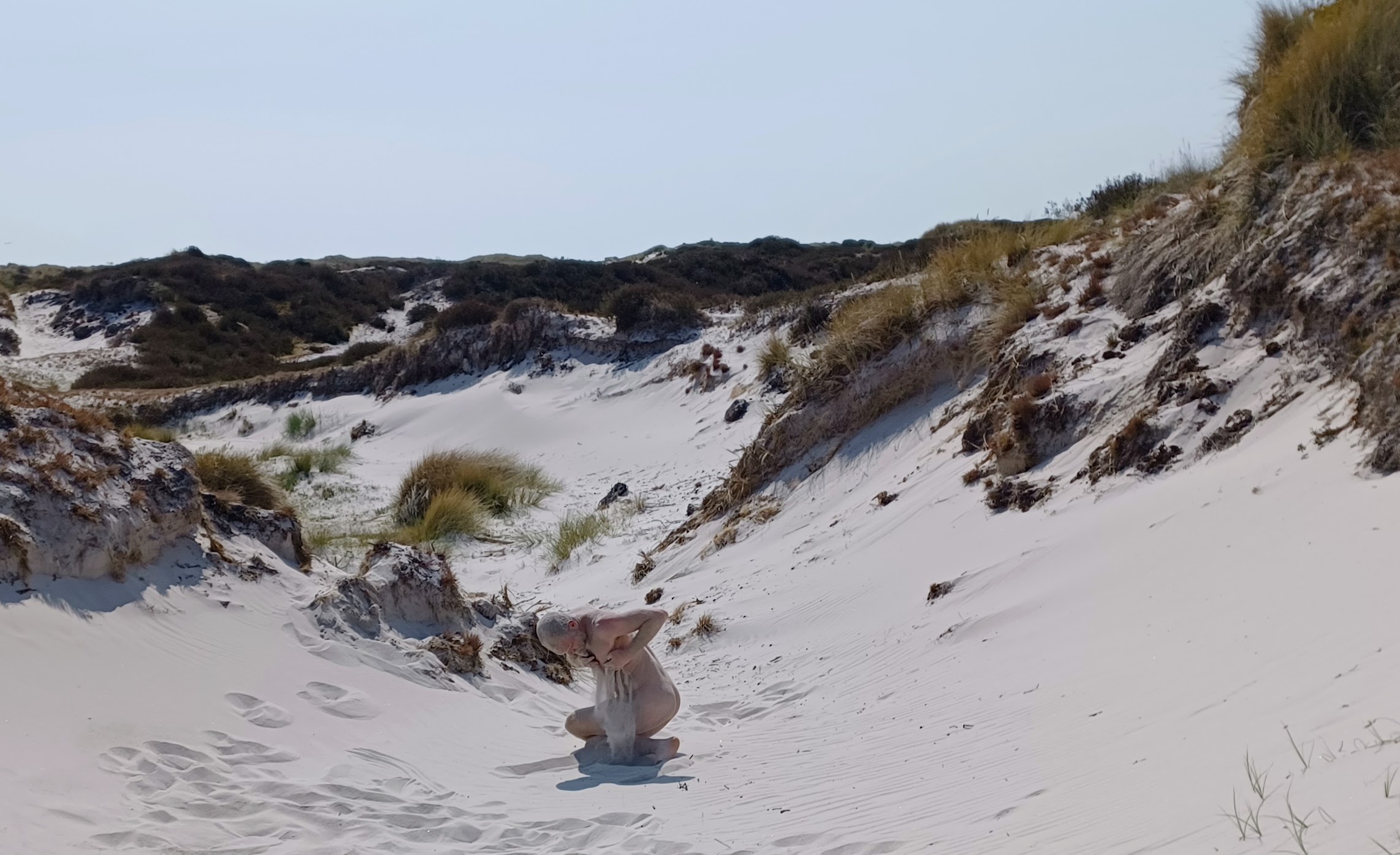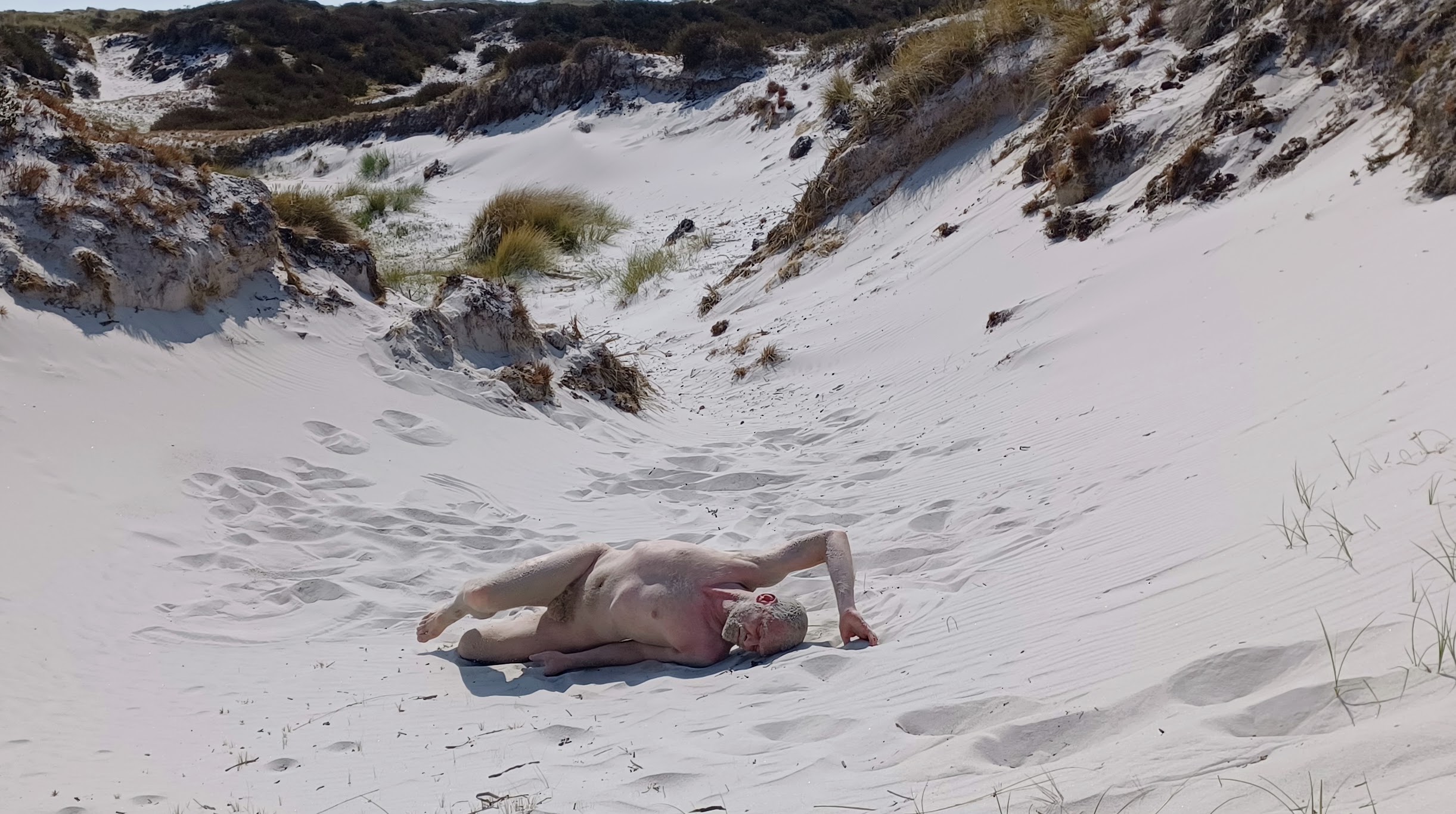Intro:
Performing Landscapes asked the artists: How can art and artists act based on the current state of the planet?
I interpreted the question environmentally and socially because I suspect that the current state of the planet is caused partly by us people by separating ourselves into boxes; man, woman, queer, human and so on. Like this we are becoming more and more estranged from one another, other species, ourselves and the environment/nature. In this sense Performing Landscapes was an opportunity to continue my ongoing research: exploring how daydreaming affects meetings between bodies, other forms and landscapes by building bridges between inner and outer worlds. And I added my own question: How can daydreaming contribute to social, physical, and emotional diversity?
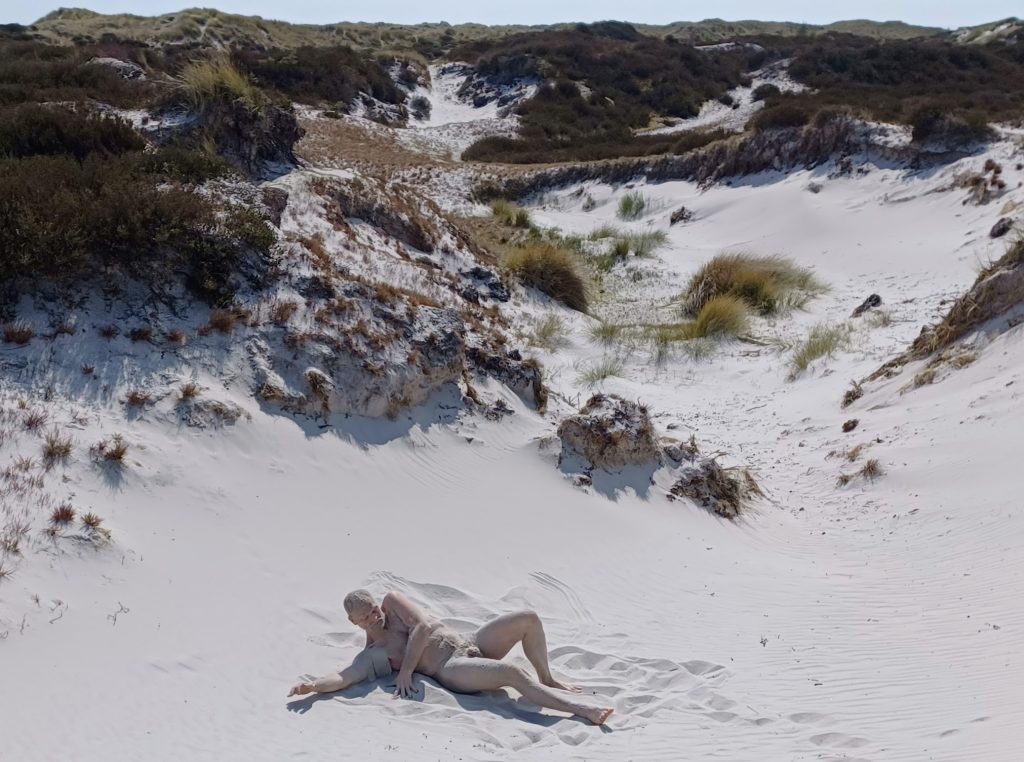
For this research I applied my three methodical approaches: Naked Embodiment; Conveyor of Abjection; and Shared Daydreaming. What I discovered was that the landscapes, combined with my abject guiding character, contain reference points, such as atmospheres, tactical objects, and social frames, which serve as common poetic themes in the daydreams of various people. As such daydreaming offers a poetic path to discover common narratives and meetings on common ground socially, physically and emotionally. What I did not discover is whether or not this is what the planet as a whole needs or if it’s my own idea of what it needs. But I am part of the planet and it feels like the planet could benefit from a more holistic understanding between entities practising on it. And I believe that my methods have the potential to explore that.
In Performing Landscapes I explored the questions in two different landscapes: Dueodde, a vast dune landscape and Bedding, an abandoned industrial landscape.
Klippekroppe (Performing Landscapes Bornholm); The dune landscape
Method:
We were 7 artists plus the producer Susanne Danig working together on Performing Landscapes Bornholm during a three week residency at BIRCA. The title was Rock Bodies, which was part of the festival Kulturugen (The Culture Week) Bornholm in September 2023. The residency culminated in 7 solo performances plus a common performance, each on different locations on the island. A large part of the investigation was to provide each other with constructive feed-back.
My location was Dueodde; a vast dune area containing some of the finest sand in the world. On the one hand it is a place to slow down and disappear from everyday life and on the other hand it is a major tourist attraction including the noise and speed of tourists. In the investigations leading up to my solo performance, I applied my artistic research methods Naked Embodiment, Conveyor of Abjection and Shared Daydreaming.
Being naked in public spaces creates situations where I am less bound by my preconceptions, it intensifies my senses, and in many situations, I can surrender myself easier and more freely to the environment. It is a way for me to intimately embody the surroundings. According to french philosopher Gaston Bachelard in his book Poetics of Space we must forget all culture and knowledge acquired in the past so that our body, soul and spirit are able to unveil the impact of poetic images and understand the images that are unconsciously formed in our minds through daydreaming (https://www.estudoprevio.net/the-poetic-of-space-by-gaston-bachelard/?lang=en).
So, musician Morten Sarkisian and I entered the dunes with our naked bodies and got intimate with their sand, reed, heather, ants, birds, footsteps, many exposed roots, sound, wind, spiders, beetles, history, dimensions, colours, tourists, textures, evanescence, forms, water and so on. We were both much more aware of the surroundings than if we had worn clothes: The sensations felt deeper, closer and with less cultural filters and we got a sharpened awareness of tourists and how our presence was a contrast to theirs in many ways. Like that I got familiar with the landscape and how it affected intimate meetings between two people. Our daydreams were about escaping into the landscape disappearing from everyday life. I did the same exercise with dancer Dorte Bjerre developing the performance and her character in it.
In another preceding investigation, I gathered a small group of artists from Cirkusbygningen i Sandvig (The Circus Building in Sandvig). Through my method Shared Daydreaming we connected our inner worlds with the vast space of dunes. In this scenario we discovered common themes of our narratives. We expressed the narratives in poetic ways due to the daydreaming nature of revealing the unconscious: The instability and evanescence of the sand exposing the roots of the many reeds and heather plants prompted feelings of the absence of home/roots; the vastness represented timelessness; The sand connected us – when one person moved, the wind took the sand of the movement and transferred it to the other persons; and the sounds of the wind and the ocean set the atmosphere.
During the research described above I applied my method Conveyor of Abjection and developed a character to convey abject aesthetics of the landscape to the participants of the upcoming performance. In this context I define the abject as the unknown, forgotten, and marginalised that potentially threaten the distinction between self and other and as such is associated with disgust, fear, nausea, etc. Thus, examples of abjection are part of ourselves/our own lives that we try to avoid because of fear, like absence of home, fragility, and timelessness. Introducing abject aesthetics is to me another way to escape predictable preconceptions. It is a way to embrace what is abject until it becomes non- or less- abject, and the landscape with me/us in it is perceived more as a whole with room for diversity. I wanted to embrace the feelings of timelessness, gender fluidity, absence of home, slowness, fragility, and intimacy. The character became a daydreaming person covered in sand, moving slowly as if just woken up after years of sleeping underneath the sand, wearing only a small skirt that almost blew away in the wind exposing my skin. The character simultaneously floated in the wind and was grounded deep in the sand in a mix of feminine and masculine traits. This character turned out to have abject features as intended and as described below.

Performance:
The 45 minute performance was a combination of my character conveying the common themes from the preliminary investigations, poetically without words, and the participants getting to experience their own daydreams guided by short, open notes. My character appeared from the dunes far away from the participants and slowly came closer to finally meet them. My character took them on a walk and encouraged them to daydream and to share their daydreams by writing/drawing in the sand. One person was a bit scared of ‘me’ in the beginning, but getting to know my character took away the fear. Another person, danish cultural mediator Bente Larsen, wrote (translated from danish):
“The afternoon begins in Dueodde, where Peter Vadim emerges from the sand as an angry and menacing demon in the same vein as E.T.A. Hoffman’s Sandman. The threat of nightmares slips into daydreams and lightness as Vadim moves through the dunes, where he is eventually joined by another poetic spirit in the form of Dorte Bjerre Jensen. The sun and light contribute to the poetic intermezzo in the sand, a mirage that slowly dissolves before our eyes and reminds us that man is a grain of sand in the infinity of nature. And we are left with awakened dreams and with the wish that this fine and present performance could have lasted longer (https://www.metropolis.dk/en-rejse-i-tid-og-rum/).”
American writer Kevin Doyle wrote:
“… I was reminded of the closing beach scene to Terence Malick’s THE TREE OF LIFE; where deceased family members are reunited with loved ones who have not aged (https://www.metropolis.dk/blog-klippekroppe/).”
So clearly the presence of my character influenced the daydreams of the participants as well as the presence of the participants themselves and Dorte Bjerre. And due to the change in their conception of my character it seems that the participants welcomed my invitation and embraced what was abject to them. But still, the themes that kept coming up in the daydreams were timelessness and a sense of home and/or absence of home. In this sense the landscape itself had an impact on the common themes of the various daydreams.
Performing Landscapes Non-Stop; The industrial landscape
Method:
A week later I performed the same concept in Bedding, an abandoned industrial landscape on Refshaleøen, Copenhagen. With conceptual support from my research on Bornholm I adapted it to a rather different landscape. Again I applied my three methods in preceding explorations; this time on my own.
The landscape in itself has abject features: It is a former industrial area abandoned, unkept, overgrown and carries a huge amount of waste. It seems as if the plants have taken over which feels wild and freeing. So I got naked with piles of soil, waste and plant remains and built up my abject character: A man in ladies wear covered in soil carrying waste very slowly and deliberately from one waste installation to another.
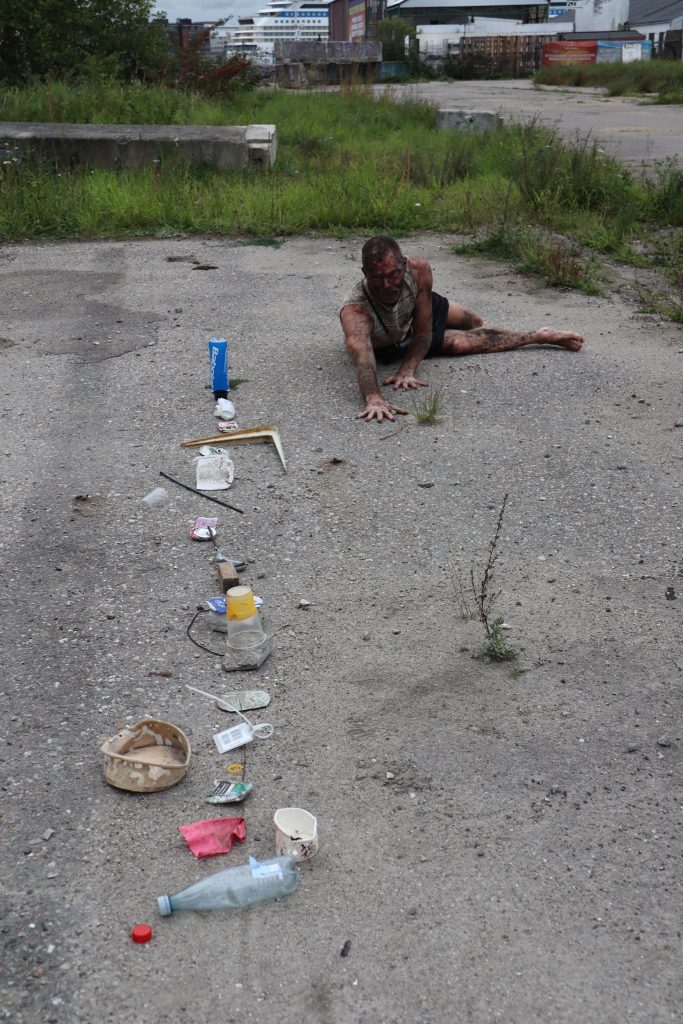
Performance:
Again I approached the participants from far away. This time one initial reaction was a very loud laughter from one of the participants. I wonder if it was a nervous laughter or someone who thought it was funny. Either way my character triggered a rather strong reaction to something unexpected. I saw it as my objective to portray this genderfluid character in less familiar ways.
Danish associate professor Karen Vedel wrote about my character: It is both strong and tender, violent and fragile, self-conscious and self-effacing, enticing and repulsive (abject).
I met the participants without words and everything I did in the following hour was with significant slowness and conviction (I guess, to invite people into a world of abjection with the objective to convey and embrace the abject has to be done with conviction based in a huge amount of preparatory work and understanding of abjection): I made installations of waste; communicated by gestures and writings on asphalt/concrete; interacted sensuously with the waste and ruderal plants; took the participants on a guided tour; the participants interacted with their own pieces of waste and made their own waste installation. Guided by my character we all interacted as if in a ritual with the common installation followed by a daydreaming seance.
The participants were then divided into groups of two or three and encouraged to share their daydreams and with chalk write/draw how their daydreams met. This time there were less narrative daydreams and images and more feelings of present ambience. There were mutual feelings of safety and energy supply. One had a daydream about it and others just felt energised and safe.
I wonder if the lack of narrative daydreams and images was partly due to the relatively short preparation I did. I mean, the more time I spend preparing the deeper I get into the landscape and the deeper I can guide the participants into the landscape away from their preconceptions and closer to their unconsciousness. Instead I relied on my own abjection being genderfluid in a heteronormative world, which is also deep enough, but it could probably have connected deeper with the landscape. But then again, people felt safe embracing my character, the waste and the wild freeing feeling of the landscape which is probably what energised them.
Film by Einar Nielsen
To summarise:
In conclusion, I believe that my Performing Landscapes project was a deep exploration of the interplay between art, the environment, and human connection. My use of three distinct artistic research methods, namely Naked Embodiment, Conveyor of Abjection, and Shared Daydreaming, turned out to be a harmonious and complementary approach in revealing poetic narratives that exist within the relationships between people and landscapes.
The exchange between Naked Embodiment and Conveyor of Abjection dismantled preconceived barriers, providing an opportunity for participants to uncover poetic imagery deeply embedded in the unconscious connections between themselves and the landscapes. This process, guided by my character and Dorte Bjerre’s character, allowed participants to embrace abject aspects of their surroundings, ultimately leading to transformative experiences.
The method of Shared Daydreaming, particularly in the form of daydreaming seances, played an important role in connecting participants to the landscapes and each other. These shared experiences encouraged narrative daydreams and images, and also fostered a collective atmosphere of safety and energy. The exchange of daydreams brought participants closer to their own unconscious feelings and perceptions, thus enhancing the depth of their connection with the landscape.
However, there is room for further development in the methods. A more systematic and pedagogical approach to guide communication during the performances could be beneficial, ensuring that the meetings between participants and landscapes are communicated and understood. Additionally, the paradox of time is worth acknowledging. While spending more time in a landscape can deepen connections and understanding of the abject and the poetic, it is compelling to balance this with the need for spontaneity and immediacy in artistic expression, ensuring that the poetics remain unencumbered by overthinking.
While questions about the broader impact of these explorations on the planet as a whole remain unanswered, my conviction in the potential for art to bridge divides and foster a holistic understanding of our relationship with the environment is visible. My project demonstrates that art and performance can serve as a medium for reimagining our connection to the planet, transcending divisions, and embracing abject aspects of our existence.
The other artist are Lene Degett, Dorte Bjerre Jensen, Ilon Lodewijks, Manon Siv, Katinka Wissing and Ben Woodhams.
Performing Landscapes is a part of the three-year project Metropolis Landscape 2021-23 organised by Metropolis – Københavns Internationale Teater with support from the Nordea Foundation and in collaboration with and with support from the local partners. The local partners on Bornholm are BIRCA and Kulturugen Bornholm.

